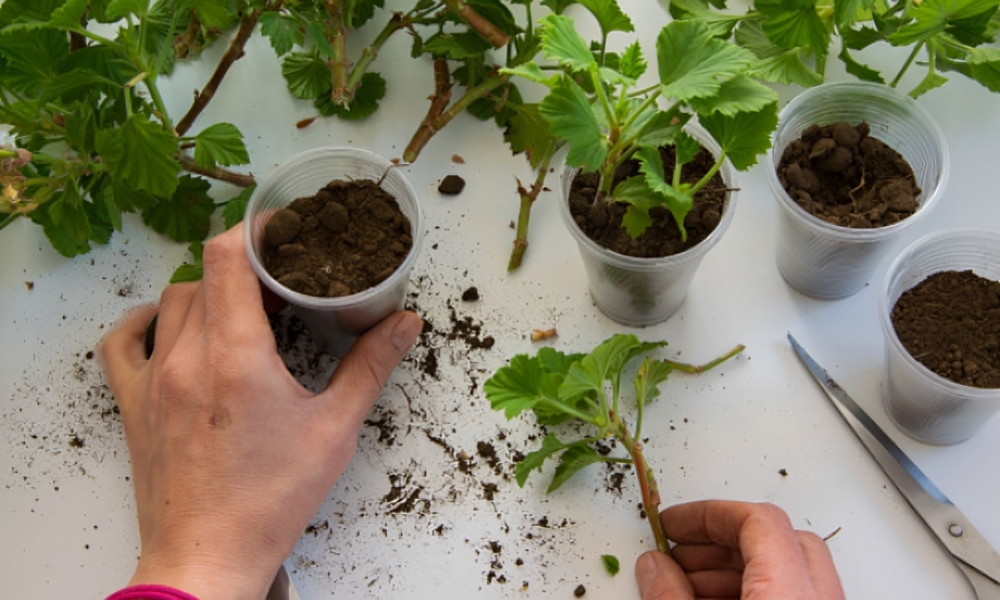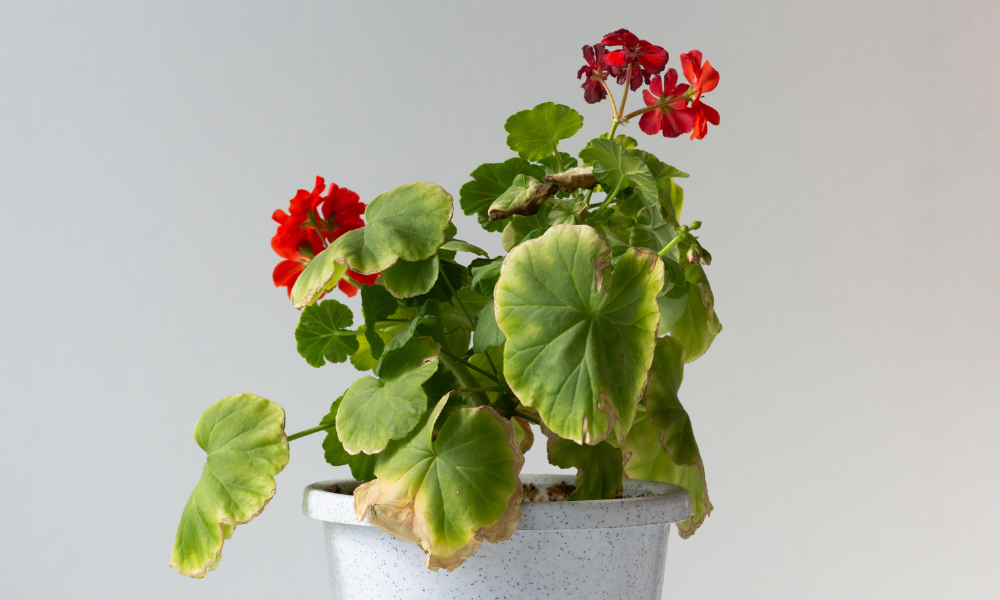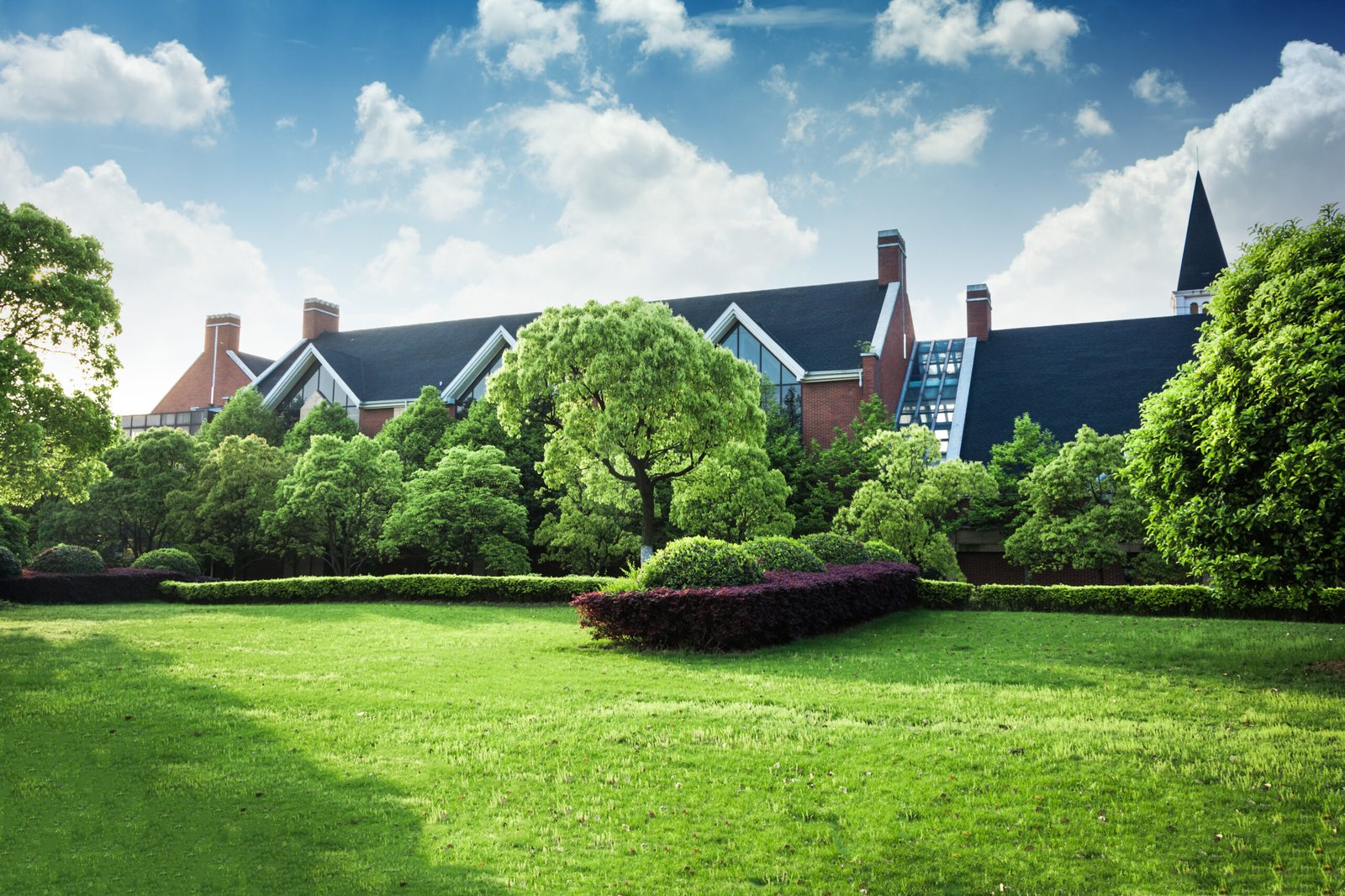Geranium (Pelargonium) is a popular flowering plant known for its brightly colored flowers and attractive foliage. It is grown as a garden top or house plant and is simple to grow with simple care and low maintenance. Geraniums grow one to three feet tall and wide, but some spreading plants can grow up to five feet. Its leaves are usually heart-shaped or rounded, and some species typically have white, cream, green, and red leaves. Geranium flowers bloom in clusters and come in a variety of colors, including red, pink, white, purple, and orange, but some species have bicolor flowers. When it comes to growing indoors, geraniums are suitable for hanging baskets and window sills in mixed containers. Although geraniums make a wonderful addition to the garden or indoor decoration, it is essential to be aware of their potential toxicity. Geraniums can be slightly toxic to dogs, cats, and rodents, so care should be taken when planting geraniums in areas where pets can easily access them.
Geranium Care

Geraniums are ideal plants for beginner gardeners because they are relatively low maintenance and simple to grow. They grow best in full sun and well-drained soil. Geraniums should be kept outdoors in summer because they are comfortable growing in warm environments, but they should be brought indoors in winter to protect them from the cold. Regular watering, growing-season fertilization, and simple maintenance help these plants grow healthily.
Sunlight & Location
Geranium is a sun-loving plant that requires 6 to 8 hours of direct sunlight per day for average growth. They grow well in warm and sunny environments. If planted in a tub, rotate it regularly to ensure sunlight reaches every part of the plant. If geranium leaves are sunburned, recovery can be aided by keeping the plants in partial shade. If the plant’s leaves turn yellow and flower production slows down, move it to a sunny location to get more sunlight to provide the light it needs.
Soil & Fertilizer
Geraniums grow best in light and well-drained soil. A suitable potting mix consisting of garden soil, peat moss, and perlite works best. The ideal soil pH for geraniums is between 6.0 and 6.5, which is slightly acidic. To add organic matter, you can mix compost or high-quality potting soil. To ensure proper drainage, it is essential to use containers with perforated bottoms to prevent waterlogging, which reduces the risk of root rot.
Geranium needs regular fertilization for proper growth. Apply liquid fertilizer once every 4-6 weeks during the growing season. A potassium-rich fertilizer is ideal because it encourages more blooms. When applying fertilizers, follow package directions to avoid overfertilizing, as over-fertilizing can damage the roots. Alternatively, you can use a slow-release granular fertilizer, which provides a steady supply of nutrients over time.
Watering
Proper watering is the key to healthy geranium growth. Water the plant when the topsoil is dry, but avoid overwatering as this can cause root rot. In summer, due to high temperatures, you may need to water more frequently as the soil dries out quickly. In winter, reduce watering as the plant’s water intake slows down and the soil retains moisture longer. Make sure the soil is well drained, and avoid water-logging at the bottom of the pot. A light mist can help keep the leaves fresh, but avoid leaving water on them, as this can cause problems. Always use room-temperature water to prevent plant stress.
Temperature & Humidity
Geraniums are sensitive to temperature and grow best in warm environments, with an ideal range of 15-20°C. They can be kept outdoors in summer but should be brought indoors when temperatures drop below 10°C to avoid damage. Cold temperatures can stunt growth and reduce flower quality.
Geraniums prefer low humidity and struggle with high humidity. They grow in dry or moderately humid environments, with indoor humidity between 40 and 50%. High humidity can soften the leaves and increase the risk of rotting. To manage humidity, ensure good air circulation, and consider using a dehumidifier or improving airflow if necessary.
Types of Geraniums

In almost all garden centers, geraniums are marketed in several cultivars, usually four or five. However, two types remain the most popular ones: zonal and ivy geraniums.
Zonal Geranium (Pelargonium x hortorum)
Zonal geraniums are standard, like their rounded leaves, which are thick green in color with a common burgundy border. From spring to fall, they bear large clusters of flowers with a diameter of four to five inches in intense shades of red, pink, and white. Most zonal geraniums are perennials in coastal and tropical climates but are grown as annuals in other places. With time and age, their stems turn into wood, making the plants look like bushes. In colder areas, such plants need to be taken indoors in the winter.
Ivy Geranium (Pelargonium peltatum)
Ivy geraniums are characterized by thick green, ivy-shaped leaves and a self-climbing growth style, making them ideal for hanging baskets, window boxes, or planters. These plants’ flowers look quite similar to those of zonal geraniums, only with thinner blooms and deep purple shades. Plants of this kind of trailing type are well-suited for making such long, droopy bouquets.
Scented Geranium (Pelargonium spp.)
Scented geraniums are adored for their foliage, which releases scents upon touching the leaves. Leafy-scented geraniums grow as compact bushes with tiny flowers, but this is not their primary purpose in cultivation. These plants are also used in food, brans, teas, potpourri, perfume, etc. Scented geraniums grow well in warm light conditions and under bright, full sun or partial shade.
Geranium Pruning

Pruning geraniums ensures the plants’ excellent health and ornamental quality. Clearing dried leaves, decayed parts, and dead stems will result in less energy loss and create possibilities for new growth. Dead blooming plant parts need to be plucked off to allow for the growth of new flowers. Trimming long or excess branches makes the plant look fuller and more attractive, as well as enabling better air and light penetration. Thinning should be done by cutting off the branches at 1-2 inches (2.5–5 cm) above the main stem. It is most appropriate to trim in spring or summer when the plant is actively growing. Trimming in winter should be avoided because the plant is not very active. After pruning, give the plant enough water and, if needed, give it the fertilization it may require for quick recovery.
Propagation Geranium

The cutting method is the simplest and most effective way to propagate geraniums. To promote those rules, follow the steps listed below:
1. Taking cuttings: In the spring or in summer, 3-4 inch long tip cuttings are cut from a healthy plant. The cutting should be at least 2-3 leaves long, with the lower leaves discarded.
2. Preparing the cuttings: This process should include two steps. First, the cutting bottom should be cut at an angle. Second, the lower leaves of the cut stem should be removed, and the lower end of the stem kept for callusing should be exposed to air for some time.
3. Utilizing Rooting Hormone: Apply the rooting hormone to the basal end of the cutting to promote its rooting habit.
4. Preparing the Soil: To prepare the soil, wet the rinds of hay-type material inside a pot. The soil’s moisture should be moderate.
5. Placing the Cuttings: Fill the cuttings in a pot to a depth of 2-3 inches and lightly pack up the soil to hold them in place.
6. Maintenance: Keep the pot in a well-lit area, but away from direct sun rays. The soil may be moist but not wet.
7. Assessing the Rooting Progress: After a few weeks, the cuttings should have developed some roots. Lightly pull on the cuttings and see if there is any resistance, which may indicate root growth.
Potting and Repotting Geranium

When potting geraniums, make sure you pick a container that has holes at the bottom for drainage. For drainage, combine garden soil, peat moss, and perlite in a humidified light soil mix. Apply the mixture to the pot; press the geranium in the middle and the soil in the center. After planting, thoroughly water the soil, but avoid allowing excess water to stagnate at the bottom. During the growing season, keep the pot in a bright area and apply liquid feed. This way, geraniums will grow and bloom quickly and beautifully.
Geraniums need to be repotted every one or two years. It is best done in spring or summer, when the plant is in season. When reporting geraniums, you need a larger pot than the previous one to accommodate the growing roots. First, remove the geranium from its old pot, and then remove the root ball. Prepare a light, well-draining soil in the new pot, position the plant at its center, and pile soil around it. Add moisture to the soil but prevent saturation; water should not stand after any delay. Set the repotted geranium in direct or indirect light with some shadow, and apply fertilizer if required.
How to get Geranium to Bloom

To ensure that geraniums bloom, it’s essential to give the plant enough sunlight. Providing 4-6 hours of direct sunlight every day increases the chances of flowering. Constant watering, as well as consistency in soil moisture, is paramount, but do not overwater the soil. Flowers should be deadheaded, and leaves and dry heads should be cut off during the flowering season to bring out new blooms instead of leaving the plant to rot. Furthermore, to increase the use of geranium, balanced liquid fertilizer should be applied throughout the summer at intervals of 4 to 6 weeks. Adequate nutrient application in the potting mix and correct pruning of the plant can also nurse it and aid its blooming.
Common Problems with Geranium

When growing geraniums, most gardeners encounter various problems, such as plants becoming tall and weak, leaves turning yellow, and failure to bloom. These problems are typically caused by either under- or overwatering, inadequate or excessive sunshine, and excessive fertilization. A few alterations would cure these problems. The following list outlines common geranium problems and their respective treatments.
Yellow Foliage
There are many reasons why geranium leaves turn yellow. Unfortunately, over- or underwatering turns some leaves yellow. This usually happens when the soil is waterlogged or too dry. Therefore, avoid overwatering and ensure adequate drainage in the pot. Another reason for the yellowing of leaves can be a deficiency of nutrients, most particularly nitrogen. To aid in this differentiation, I recommend adopting a spine. In addition, fungi or viruses can cause yellow patches on the leaves. Pull off the affected leaves and check how the plant is doing. Lastly, check that there is enough light and adequate circulation for the plant.
Spindly Growth
Thin and weak growth in geraniums is often the result of a lack of light or too much watering. One major enemy of this geranium is the lack of sunlight, which can make the plant spindly and weak. Place the plant in a position where it will get plenty of direct sunlight, and in addition to that, use additional grow lights where necessary. Other causes could include overwatering or soil becoming too dry. Make a habit of checking soil moisture content and holding watering time accordingly. Providing adequate care and fertilizer will improve plant health.
Failure to Bloom
In geranium plants, common problems involving the cessation of flowering are usually caused by a few factors: low light exposure, felting, and poor irrigation due to the presence of excess cold. To promote the growth of perfect flowers, ensure the plant receives sufficient light, rinse it sufficiently to moisten the fertile layer after its surface dries, avoid frequent fertilizer use, and protect it from extreme cold.
FAQ
Are geraniums suitable for herb gardens?
Geraniums may serve as ornamental plants in herb gardens, but they have no culinary use. They are grown for their decorative leaves and flowers, not for any culinary purposes. Bright-colored and fragrant geraniums can enhance the appearance of the garden with herb features.
Does Geranium bloom every year?
If Geraniums are well maintained, they usually flower every year. They bloom mainly during summer, usually whenever summer reaches its peak from spring to autumn. Some dormant periods or varieties during the winter do not produce many flowers. However, assuming the right amount of light, water, and fertilization, this geranium can bloom back to life every succeeding year.
Can Geranium be grown outdoors?
There are geraniums that can be used in both house plights and the garden. In the summer season, they relish the sun and warmth; thus, they can be planted on flower beds, pots, or placed on hanging baskets. They should be safeguarded from the winter cold by positioning them indoors as the outside climate becomes severe.





















